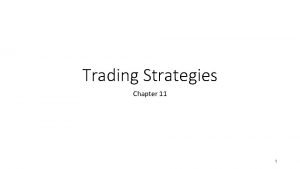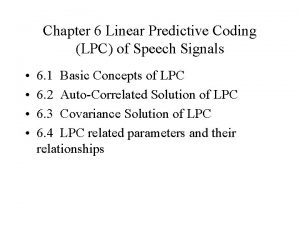Call to Action NEL LPC Hemant Patel Secretary









- Slides: 9

Call to Action: NEL LPC Hemant Patel Secretary NEL LPC

Procrastination �Everyone procrastinates sometimes, but 20 percent of people chronically avoid difficult tasks and deliberately look for distractions— which, unfortunately, are increasingly available. Procrastination in large part reflects our perennial struggle with self-control as well as our inability to accurately predict how we'll feel tomorrow, or the next day. Procrastinators may say they perform better under pressure, but more often than not that's their way of justifying putting things off.

Types of Procrastinators (1) � The Perfectionist These people don’t want to finish, or even start, a project that they fear won’t be perfect. They waste time refining and honing their work, but adding no value. � The Dreamer These people are better at ideas than execution. Actually doing the work seems tedious and boring. They are vague about how to make things happen and tend to believe they’ll be magically rescued. � The Worrier These people fear risk and always worry “what if? ” They put off acting if it means doing something unfamiliar or uncomfortable

Types of Procrastinators (2) � The Defier These people hate feeling controlled by others. The feel oppressed by mundane chores. “You can’t make me” is their line. � The Crisis Maker These people are adrenaline junkies. They thrive on and even create near disasters because they’re exciting. � The Over Doer These people are indecisive and unassertive. They say yes to everyone and then get stuck. They over commit and burn out.

You can do anything you set your mind to do. But you just can't do it alone.

The Six Layers of Resistance to Change (1) � Layer 1 - "We don't agree on the problem. " Identification and confirmation of the current constraint, usually perpetuated by a debilitating dilemma or chronic systemic conflict � Layer 2 - "We don't agree on a direction for a solution. " A breakthrough idea for dealing with the root cause of identified symptoms � Layer 3 - "We don't have an effective solution" Clear vision of the system-wide solution, its desired outcomes, and its implications

The Six Layers of Resistance to Change (2) � Layer 4 - "Yes, but. . . " (Reservations about undesirable side effects) Identification and consideration of concerns, reservations, and risks that may be encountered in implementing the proposed solution � Layer 5 - "We can't do it because. . . " Identification of and planning to overcome obstacles to implementing the solution � Layer 6 - Unverbalised fear Comprehensive "Change Management" for necessary personal buy-in of all key players

Workshop 4 key questions around: �creating a ‘pharmacy first’ culture �ensuring patients get the best from their medicines �integrating community pharmacy into the patient pathway �Increasing safety of dispensing


















